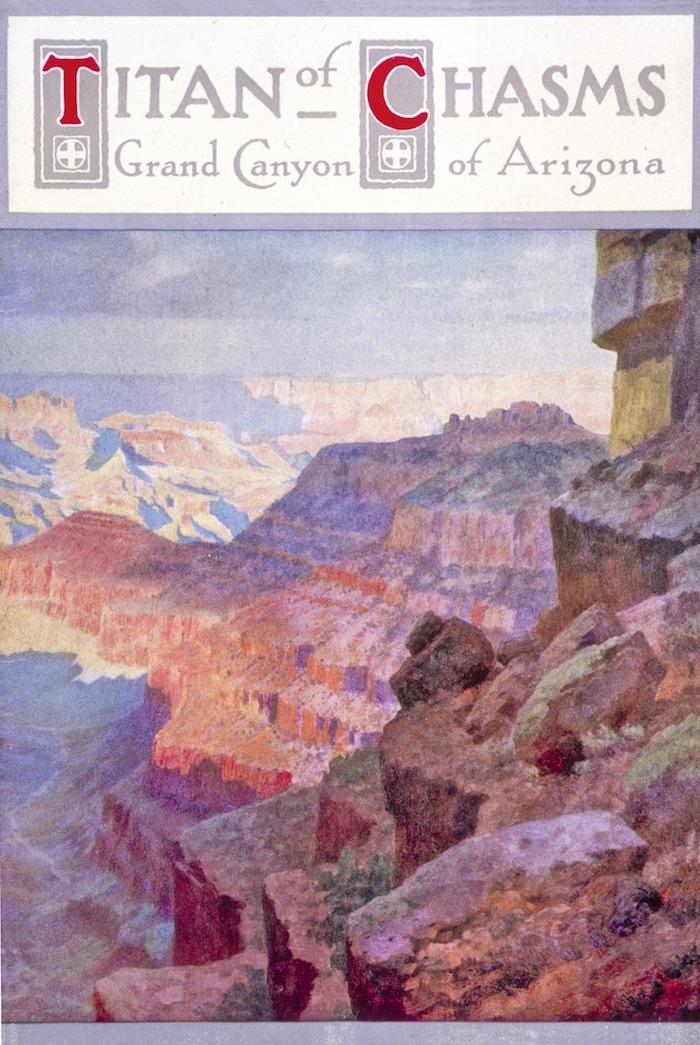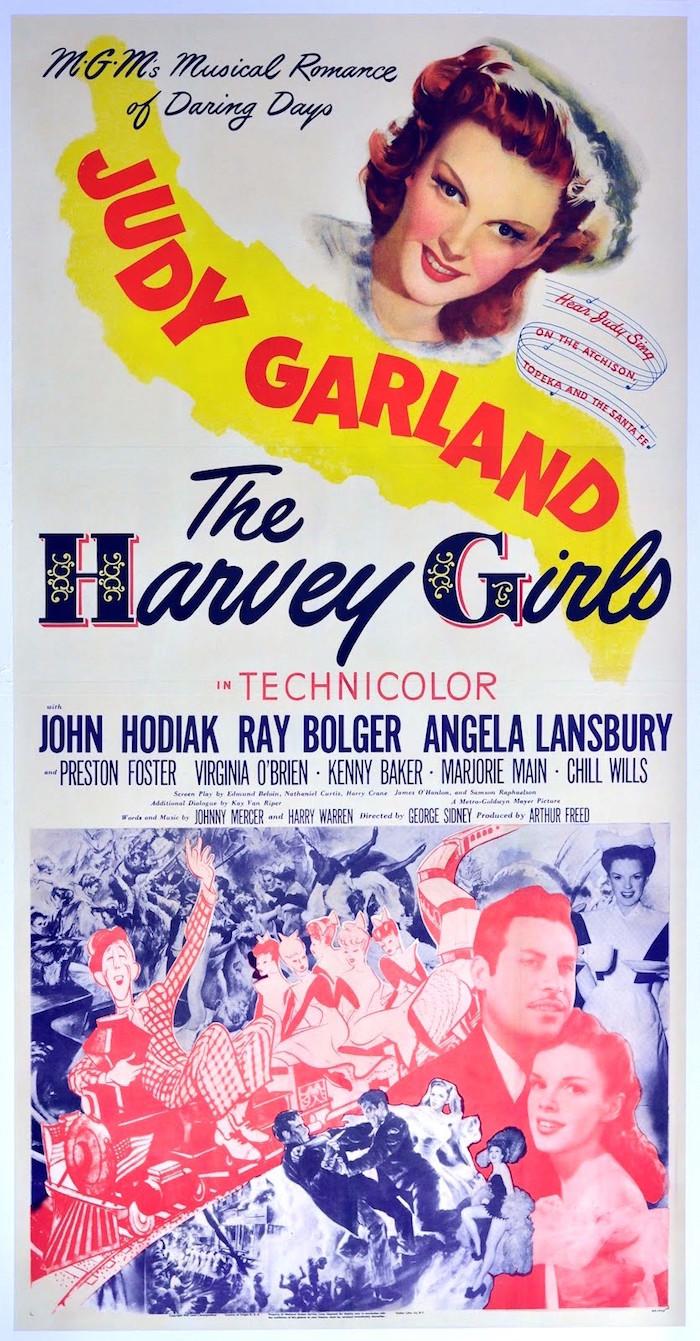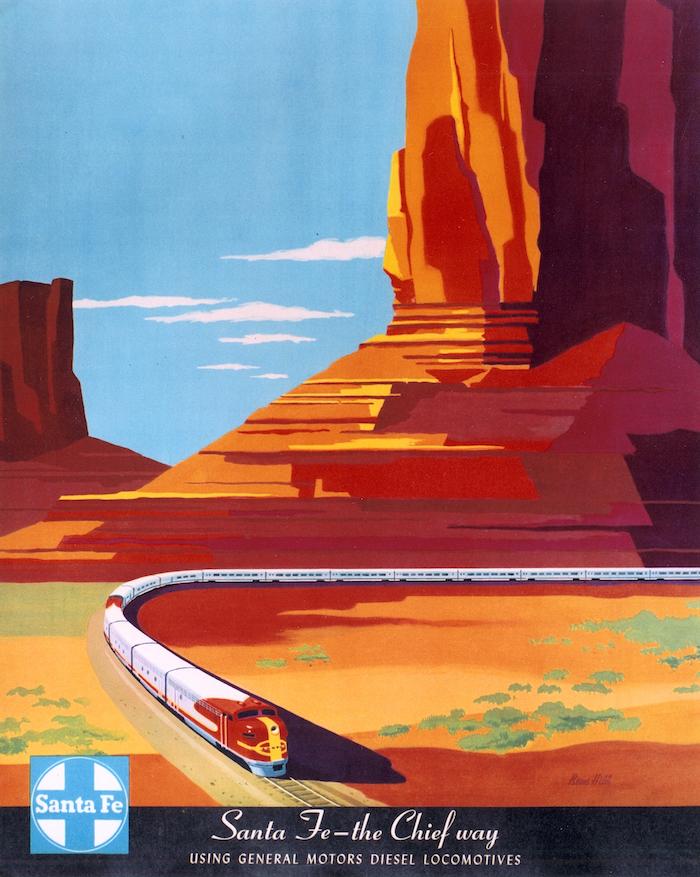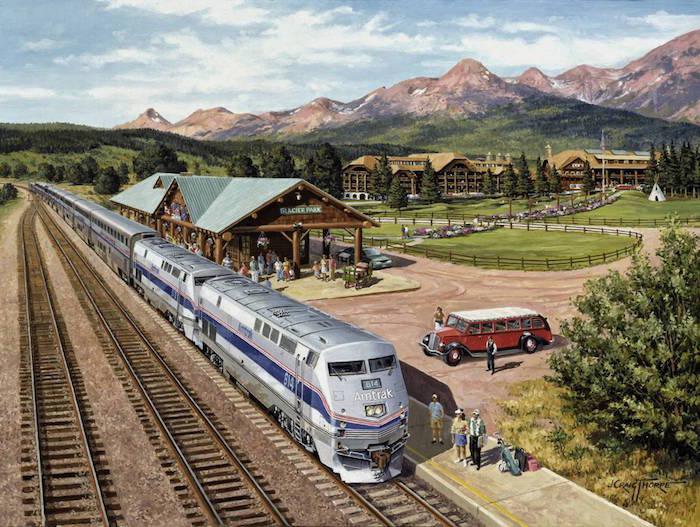
Published by the Santa Fe Railway, Titan of Chasms alerted California-bound passengers to the railroad's most popular side trip, here in 1915. Today operated by Xanterra Parks & Resorts as the restored Grand Canyon Railway (1989), the 65-mile historic spur carries more than 200,000 passengers between Williams, Arizona, and South Rim annually. Author's collection.
Editor's note: National parks historian Alfred Runte has over the years closely watched how Congress has managed and funded Amtrak. Although funding for Fiscal Year 2019 is halfway to being assured -- the Senate has approved $50 million for the railroad, but the House of Representatives has yet to take up the measure -- he reminds us that only weeks ago Amtrak’s board approved the scenario here. A stay of execution for the Southwest Chief aside, Dr. Runte continues to lobby for the trains Americans deserve—and notes how to make that possible.
Anticipated by fall, planned cutbacks approved by the Amtrak board would truncate the Southwest Chief.
Imagine you’re a European travel agent with a client who wants to visit Grand Canyon National Park. She would prefer to take the train. At your local library you find a copy of Trains of Discovery: Railroads and the Legacy of Our National Parks, and start making plans from there. A few pages in, you learn that America’s railroads were instrumental in establishing the national parks—and the National Park Service. And yes, a train to Grand Canyon is available. It’s called the Southwest Chief.
Departing daily from Chicago and Los Angeles, the Amtrak passenger train makes the 2,265-mile journey end-to-end in about two days. At Flagstaff, Arizona, a shuttle transfers passengers to the Grand Canyon Railway at Williams and the remaining 65 miles to South Rim. The Grand Canyon Railway, privately restored in 1989, is a remarkable story in itself. Another piece of history, the Harvey Girls, explains how the Southwest captured America’s heart.
Who were the Harvey Girls, your client asks? You recommend the movie starring Judy Garland. Meanwhile, she should start in Chicago, so she, too, can watch the West unfold.
Although no longer the Atchison, Topeka & Santa Fe, the Amtrak route is flanked by glorious scenery. And a few remaining Harvey Houses, notably La Posada in Winslow, Arizona. Also the stop for the Southwest Chief, a yawning gate greets arriving passengers, while, to the delight of guests, today’s railroad, the Burlington Northern Santa Fe (BNSF), sends scores of freight trains past the hotel property.
From that description, your client is sold on the trip. Weeks later, from her seat aboard the Southwest Chief in Chicago, she informs you the train left Union Station on time. "Wonderful," you send her a text in reply. And you say Amtrak actually washed the windows?
As the Southwest Chief speeds west from Chicago, passengers enjoy the lush fields of Illinois before crossing the Mississippi River into Iowa. By morning, with Missouri behind, the train arrives in Dodge City, Kansas. Soon in Colorado, and seemingly in the middle of nowhere, your client is in for a big surprise. “La Junta!” the conductor barks, then adds a startling announcement: “Last stop! Everyone off the train!”
“Last stop?!” your client exclaims. “But I’m going to Grand Canyon!”
“Not with Amtrak,” the conductor retorts. “Starting today, we’re no longer running the train through to Los Angeles. We do provide a connecting bus, but that only goes as far as Albuquerque.”
By now, totally incredulous, your client texts you back: “I’m stuck in La Junta, Colorado! What is this? Another fast one by Donald Trump?!”
You know better, by now having read another book, Allies of the Earth: Railroads and the Soul of Preservation. Both political parties have failed the public. Amtrak started as a mess, and became an even bigger mess. After all, that’s the way Congress and the railroads wanted it.
Debating Amtrak in 1970—leading to its launch the following year—Congress still expected its life to be brief, likely no longer than five years. The whole point of Amtrak was an orderly transition, that as opposed to dropping every train at once.
And still, on beginning operations May 1, 1971, Amtrak threw order to the winds, cutting all but 180 of the nearly 400 trains it had inherited from the railroads just the day before.
And to think, as of 1929, the United States had 20,000 intercity passenger trains. By 1939 they included the ten fastest trains in the world, with names like Hiawatha, Twentieth Century Limited, and Super Chief.
But back to 1971. The fix was in and Congress knew it. It was just a matter of time.

Movie poster for "The Harvey Girls" (1946). MGM
Out Of Gas
Just as suddenly, if not quite out of the blue, Amtrak won a reprieve. The irony is from where and by whom—OPEC. By the fall of 1973, the cartel, centered in the Middle East, was withholding millions of barrels of oil from U.S. markets. Take that for supporting Israel, they said.
By Christmas and well into the spring of 1974, American motorists found themselves trapped in gas lines. Please, God! Let one filling station still be open! To be sure, often the waiting cars and rising tempers stretched around the corner for blocks.
In Washington, D.C., Congress panicked. Should the worst case scenarios prove true—and OPEC not give in—America’s aging railroads, and likely even Amtrak, would be needed to keep the country moving. Of course, when oil reached OPEC’s target price, poof! The gas lines disappeared. The public soon forgot how close the nation had come to unraveling, but in the next election did choose a Democrat.
No matter, the moment Jimmy Carter settled in at the White House, Amtrak was back on the chopping block. What energy crisis? A trained engineer, President Carter wasn’t fooled by OPEC or experts predicting the so-called end of oil.
However, by then Amtrak itself had seen an opportunity for survival, having hunkered down, as of 1976, in the one place Congress had actually bought tracks for the company—the Northeast Corridor. Granted, the long-distance trains generated 60 percent of Amtrak’s business, but that required dealing with the railroads.
Allegedly (and Amtrak alleged it vigorously), what it called emerging corridors were the future, and its tracks, so-called BosWash (Boston to Washington via New York, Philadelphia, and Baltimore) the granddaddy corridor of them all.
Indian Country
And thus the disconnect leading to La Junta and your stranded client. A remade Amtrak, arguing only for itself, determined to jettison the national system.
Too cynical? That’s what I thought—until joining the fight for the national system on Capitol Hill. Why not have more trains to the national parks, I asked Amtrak’s vice president of marketing? “You mean Indian Country?” he replied derisively. “I don’t want the cowboys and Indians market,” he added, and shuffled off.

By the artist Bern Hill (ca. 1950), this idealized poster of the Santa Fe Railway before Amtrak is now a reminder of what the country lost. Poster dimensions 24 x 18 inches. Author's collection.
He meant it, too, insisting that every train west of Chicago should be dropped and its equipment assigned to one or more of the corridors. Amtrak, making good the promise, then cut the last train to Yellowstone National Park, the North Coast Hiawatha, in October 1979.
True, no sooner had Jimmy Carter left the White House than Ronald Reagan picked up the drumbeat. However, the crippling cuts—and voodoo economics—had begun under President Carter. Reagan was just following through.
Face it. History determines outcomes. History alone has protected the long-distance trains, that is, what few of them remain. Every time Amtrak or the White House tried to finish them off, the American public—fondly recalling that history—reared up and cried no way.
This time I’m not so sure. Allegedly, some in Congress hope to win additional funding for the Southwest Chief, but that’s never stopped Amtrak before.
The Big Lie
Certainly, they continue to claim the Northeast Corridor is profitable, while everything else is a bust. Rather, the Northeast Corridor could be profitable—and would be profitable—if only Amtrak didn’t have to run the long-distance trains.
The facts are just the opposite. As I wrote for the Washington Post in March 1979, the long-distance trains are the money-makers, indeed, the cash cows holding up the Northeast Corridor.
Wait a minute. That doesn’t make sense. Certainly you would think—if the long-distance trains were abolished—the Corridor would then fail, as well.
Indeed it would, nor did I ever say Amtrak made sense. What I did say is that its failed beginnings invariably structured its corporate culture. Finally, it’s all about peddling half truths.
In truth, Amtrak has never made a profit. And that’s the irony of it. Even Congress prefers half truths.
Others point to another truth. Nearly twenty percent of Congress comes from Corridor states.
No matter, the facts speak for themselves. The long-distance trains, packed with tourists, provide a stability the corridors lack. In the first place, they run 24, 48, and 72 hours at a clip, during which the turnover between stops is constant. Each resale, whether in the sleeping cars or coaches, allows another premium to be charged for that ticket. Second, who cares if the train is a few hours late? Corridor riders care; they’ve missed their meeting. Tourists are seldom in a rush.
This is to explain why “the cowboys and Indians market,” as that Amtrak executive put it, is the one market, back in 1971, that even the western railroads thought they should keep.

Serving Glacier National Park, Amtrak's Empire Builder, as depicted by J. Craig Thorpe, arrives East Glacier Park Station from Seattle, Washington. Permission of the artist
Two did, at least temporarily, the Rock Island and Rio Grande. Why not the rest? Again, remember the fix; Amtrak was supposed to fail. In that case, all of the feeder routes into Chicago would be gone. Everyone, as did your client, would first have to board a plane.
As it stands, the public is growing suspicious. How is it that Amtrak, contrary to the airlines, believes solely in short-haul markets?
As I said in the Washington Post: “The economics of short-haul passenger service are as simple to understand as the analogy of the cab driver who refuses to go around the block when he can pick up a fare out to Dulles. . . People in the corridors simply don’t ride far enough to generate enough revenue to cover the fixed costs of building and maintaining the system.”
Europe knows this—and overlooks it. But Europe also fills in the blanks. Never have we admitted, as has Europe, that passenger trains are critical for the economy. American tourists, flocking to Europe’s trains, spend billions of dollars vacationing abroad.
To that we just throw up our hands and say: But they’re small countries! Case closed!
No, case reopened. The argument is pure bunk. Together those “small” countries still make up a continent. We lost our trains by selling our continent short.
Dump Amtrak
But dump our European guests in La Junta? Then demand they take a bus? Even if the Southwest Chief is saved—for now—Amtrak is renowned for doing much worse.
As airline critics put it, I say we stop thinking from the middle seat. Better we should dump Amtrak than put up with its nonsense for another 50 years.
Note carefully, however, how I said that. Dump Amtrak—not the passenger train.
It’s time the railroads took them back, and yes, we should be willing to pay what it costs. After all, we’re paying Amtrak now to be just plain stupid. What do we have to lose?
History suggests a time-tested formula—cost plus seven percent. During World War II, with our backs to the wall, we did exactly that. Build the airplanes and tanks and give us the bill. We the taxpayers will add seven percent.
Of course, no scrimping on quality—and not another Amtrak. We want the best tracks, signals, rolling stock, and maintenance.
A train to Grand Canyon? Actually, we deserve three—one every morning, afternoon, and evening. And that’s another thing about Amtrak—often its only train arrives in the dead of night.
Allegedly, even BNSF is finally appalled (their word). The Southwest Chief should not be cut. Fine, then is the railroad appalled enough to take it back? No, but what would Warren Buffett say (he owns the railroad) if we offered him cost plus seven percent?
Finally, we might then give Amtrak what it wants—the right to operate just the Northeast Corridor. When they fail (as surely they will), Congress can restructure that, as well.
Right now, I’m more concerned about the Grand Canyon, and yes, Glacier National Park. Were the Empire Builder, like the Southwest Chief, to be scuttled, another great park would be isolated. Where is it written that everyone is obligated to drive, playing bumper tag with heavy trucks?
I know. I’m the mad uncle again ruining everyone’s Sunday dinner. But raise your hands, and be honest. How many people you loved have died in traffic accidents? A friend of mine in junior high school died when hit by a train, but she was in a car.
Stop, look, and listen, and for once, be informed. Dare to question Amtrak’s “authority.” Even some in Congress finally admit its accounting methods are bogus. If only Congress would enforce the admission.
What Congress does best is spend your money. So, tell them how you want it spent. No more spending on Amtrak. Cost plus seven percent. For once you want a rail passenger system the country can be proud of. Mediocrity is just not service.
Subsidy? You don’t care what they call it. Just get the job done and keep the trains. You love Indian Country; you love the national parks. It’s Amtrak that belongs in Hells Canyon.



Comments
Absolutly! Even before the interweb, airlines managed to hamdle resevations across differenf carriers.
y-p-w - That is a total misinterpretation of the intent of the commerce clause. Congress was granted the power to "regulate commerce", i.e make it regular. Insure there were not unfair barriers to cross state line activities. It had no intention of the Federal government building a huge transportation infrastructure.
Hmmm. Is that what every court case and supreme court decision on the matter says? Just curious, because I've been busy having a career of saving lives rather than making a profit. Surely you've had more time to read them all. Please, obiwan, give us the detailed results of your reading.
Buck...
And if I went to those same sources I'd get the same conservative bias you have. I don't care much about that - I understand perfectly well how people get to be like you. I was one of you over 30 years ago, but developed a conscience.
What I never did in my conservative days was to scorn ["saving lives" ] people doing what I couldn't do at that time, actually saving lives. And no, Mr Buck, it wasn't only me. Many people with my training have had the opportunity to save lives. It is simple and true - many times I've been the one who made the difference. It's what we do, and without the insulting quotation marks. On the other hand, I'm a lousy money manager, go figure. It's why my wife handles the household finances.
Going to the founding documents would give you a conservative bias? Perhaps, but what it really would do would give you a perspective on the founding principles that made this country so great. Which is probably why you want to get as far away from them as you can. Conservatives have a conscience, they just don't believe lawlessness and giveaways are the best path to the greater good. And no, I don't "scorn" anyone for saving lives. Unlike you, I don't scorn anyone for having pursued any legitimate career path.
It's not so much that, but the interpretation of such documents in a narrow fashion. There are a ton of things in our founding documents that just don't fit in a modern world. Heck - the Constitution accounted for slavery. I certainly believe that there are basic principles in the Constitution that allow a more modern interpretation, and there's no putting the genie back in the bottle.
However - as it pertains to railroads and federal transportation projects, it's already settled law that the federal government can do that. As I said earlier, the federal government allowed the freight railroads to acquire rights of way via eminent domain, and part of the deal was that they would operate passenger railroads. Most of them got out of it via the Rail Passengers Service Act which formed Amtrak.
Thanks for the wonderful illustrations accompanying this article, Dr Runte!
YPW's example of slavery as one of the Constitution's shortcomings in the modern world is spot on. Weren't the Interstate Highways that helped kill passenger trains promoted as defense infrastructure? I think some of the founding fathers would be horrified to learn the United States has such a huge military budget with troops and bases in so many countries:
"In time of actual war, great discretionary powers are constantly given to the Executive Magistrate. Constant apprehension of War, has the same tendency to render the head too large for the body. A standing military force, with an overgrown Executive will not long be safe companions to liberty. The means of defence agst. foreign danger, have been always the instruments of tyranny at home. Among the Romans it was a standing maxim to excite a war, whenever a revolt was apprehended. Throughout all Europe, the armies kept up under the pretext of defending, have enslaved the people. "
James Madison, Speech before Constitutional Convention (6/29/1787)
"This, in my opinion, accounts for the almost theological attachment to the Constitution many Americans exhibit, and it explains the constant refrain one hears, especially from the right, that American democracy would work just fine if only we would restore the original Constitution. To the contrary, it is the very defects of the original Constitution that led to the ill-fated, ad hoc adjustments (and their depredations) by the living-document crowd. And worse, it was these very constitutional deficiencies that permitted the self-interested usurpations by politicians and judges that plague us today. Failing to acknowledge these facts and insisting instead that restoring the original constitutional design will set everything right in the natural order only reinforces and amplifies the document’s original flaws."
https://www.forbes.com/sites/lawrencehunter/2012/07/29/both-james-madiso...